Information for the ward based on Statistics New Zealand census and population data
- View ward boundary map
- View 2018 census data for all sixteen wards and six community boards [XLSX, 1.5 MB]. Includes selected graphs for each ward.
Population
- In 2018, the population of Hornby ward was 23,300. This was 6 per cent of Christchurch City's population.
- Between 2013 and 2018, this ward's population increased by approximately 2,200 people, or 10 per cent. Christchurch City's population increased by 8 per cent.
| Area | 2006 | 2013 | 2018 | % change 2013-2018 |
|---|---|---|---|---|
| Hornby ward | 18,900 | 21,100 | 23,300 | 10% |
| Christchurch City | 348,500 | 341,500 | 369,000 | 8% |
Census usually resident population count, 2006-2018
Population statistics - user guide(external link) provides an overview of the different population statistics produced by Statistics New Zealand(external link).
Life-cycle age groups
- The median age in 2018 was 36.1 years for people in Hornby ward. The median age in Christchurch City was 37.1 years.
- This ward had a higher proportion of people aged 15-39 years, and a lower proportion of people aged 65+ years, than for all of Christchurch City.
- In this ward, 17 per cent of people were aged under 15 years, 39 per cent were aged 15-39 years, 31 per cent were aged 40-64 years, and 13 per cent were aged 65 years and over.

Age groups, 2018
Ethnic groups
- The most common ethnic group in Hornby ward was European, with 68 per cent of the population identifying with this ethnic group in 2018. This was compared with 78 per cent for Christchurch City as a whole.
- The next most common ethnic group in Hornby ward was Asian (21 per cent), followed by Māori (13 per cent), Pacific Peoples (6 per cent) and Middle Eastern/Latin American/African (MELAA) (1 per cent).

Ethnicity, 2018
Note: Includes all people who stated each ethnic group, whether as their only ethnic group or as one of several. Where a person reported more than one ethnic group, they have been counted in each applicable group. As a result percentages do not add up to 100. MELAA = Middle Eastern, Latin American and African. The vast majority of people counted in 'Other Ethnicity' recorded ''New Zealander'' on their census form.
Birthplace
- 27 per cent of people in Hornby ward were born overseas, compared with 27 per cent for Christchurch City as a whole.
- For people born overseas who are now living in Hornby ward, the most common birthplace region was Asia (60 per cent). For Christchurch City, the most common birthplace region was Asia (43 per cent).
- Most overseas-born migrants living in Hornby ward had been living in New Zealand for 10 years or longer (48 per cent).
- Half of overseas-born migrants living in Christchurch City had been in New Zealand for 10 years or longer.
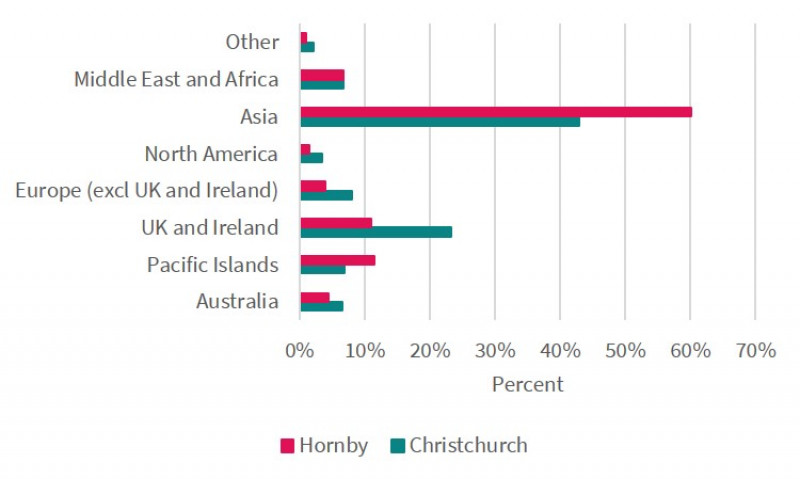
Birth region (overseas born), 2018
Languages spoken
- After English (95 per cent), the next most common languages people could speak in Hornby ward were Northern Chinese (3 per cent, 760 people), Tagalog (3 per cent, 700 people), te reo Māori (3 per cent, 670 people), and Sinitic not further defined (2 per cent, 460 people).
- For Christchurch City as a whole, the most common language apart from English is te reo Māori, spoken by 7,850 people (2 per cent).
- New Zealand Sign Language is used by 0.8 per cent of people in Hornby ward, compared with 0.6 per cent of people for all of Christchurch City.
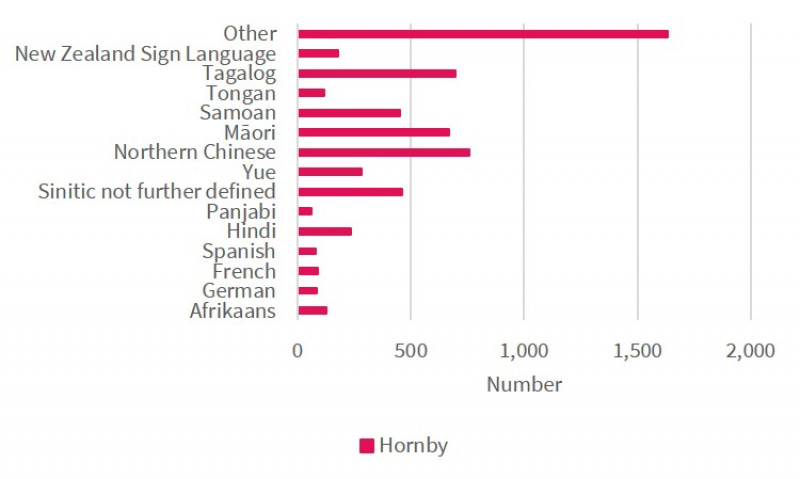
Language(s) spoken (excluding English), 2018
Work and labour force status
- In 2018, 53 per cent of those aged 15 years and over in Hornby ward were employed full-time, compared with 50 per cent city-wide.
- 12 per cent were employed part-time, while 30 per cent were not in the labour force (e.g. students who do not also work, retired people, stay-at-home parents, and those unable to work due to sickness/disability).
- In 2018, 4 per cent of people were unemployed, compared with 3.8 per cent for all of Christchurch City.
Occupation
- The most common occupational group in this ward was 'Technicians and Trades Workers' (16 per cent). 'Professionals' was the most common occupational group in Christchurch City (24 per cent).
- The next most common occupational groupings in this ward were 'Labourers' (15 per cent) and 'Professionals' (14 per cent).

Occupation, 2018
Study status
- 8 per cent of people aged 15 years and over were engaged in full-time study, compared with 10 per cent city-wide.
- 3 per cent of people aged 15 years and over were engaged in part-time study. This was the same proportion for Christchurch City.
Highest qualification
- In 2018, 76 per cent of people aged 15 years and over in Hornby ward had a formal qualification, compared with 83 per cent for Christchurch City as a whole.
- In Hornby ward, 16 per cent of people aged 15 years and over held a bachelor's degree or higher, compared with 26 per cent for Christchurch City as a whole.

Highest qualification, 2018
Households
- In 2018, there were 8,150 households in Hornby ward.
- The majority of these households (67 per cent) were one-family households. This was compared with 65 per cent for all of Christchurch.
- One-person households made up 22 per cent of all households, compared with 25 per cent city-wide.
- Other multi-person households (e.g. flatting situations) made up 7 per cent of this ward's households, compared with 7 per cent city-wide.
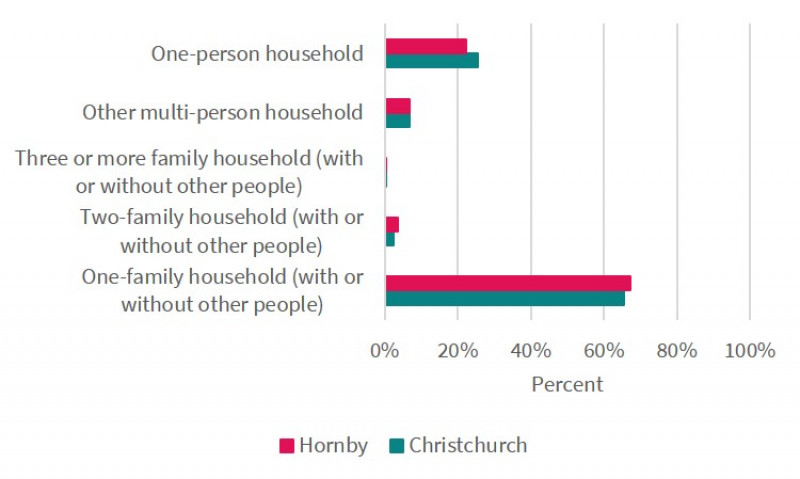
Household composition, 2018
Families
- In 2018, there were 5,990 families living in Hornby ward.
- 42 per cent of families were couples without children, compared with 43 per cent city-wide.
- 39 per cent of families were couples with child(ren), compared with 41 per cent city-wide.
- 18 per cent of families were one-parent with child(ren), compared with 16 per cent city-wide.
Household access to telecommunications
- 86 per cent of households in this ward had access to the internet, compared with 87 per cent of all Christchurch households.
- 92 per cent of households had access to a cellphone/mobile phone, compared with 92 per cent city-wide.
Personal income
- The median personal income for residents (aged 15 years and over) living in Hornby ward was $32,300 in 2018. This was compared with a median of $32,900 for all of Christchurch City.
- 34 per cent of people aged 15 years and over in this ward had an annual income of $20,000 or less, compared with 33 per cent of people for Christchurch City as a whole.
- In Hornby ward, 28 per cent of people aged 15 years and over had an annual income of more than $50,000, compared with 32 per cent of people in Christchurch City.
- In this ward, 12 per cent of people aged 15 years and over were receiving a main government benefit (unemployment, DPB, sickness or invalids). This was compared with 11 per cent for Christchurch City as a whole.
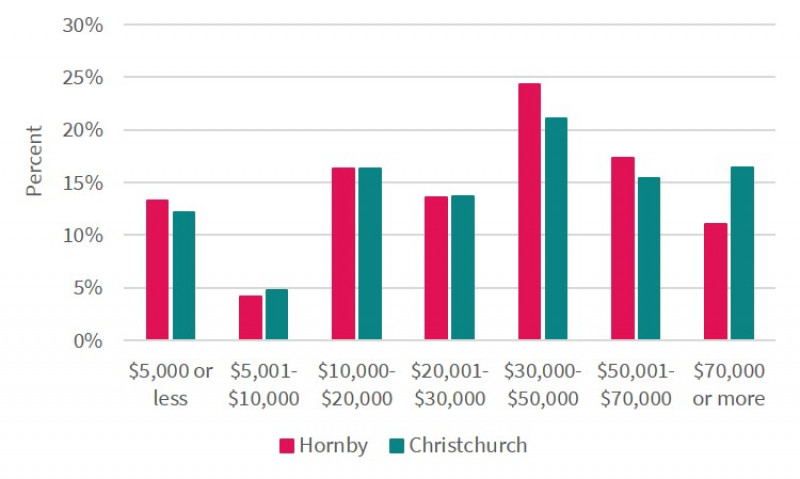
Personal income (population aged 15 years and over), 2018
Household income
- The median income for households in Hornby ward was $72,300 in 2018. This was compared with a median of $73,900 for all of Christchurch City.
- 18 per cent of households in this ward had an annual income of $30,000 or less, compared with 19 per cent of people for Christchurch City as a whole.
- 33 per cent of households in this ward had an annual income of more than $100,000, compared with 36 per cent of households in Christchurch City.
Family income
- The median income for families living in Hornby ward was $78,700 in 2018. This was compared with a median of $87,600 for all of Christchurch City.
- 11 per cent of families in this ward had an annual income of $30,000 or less, compared with 10 per cent of families for Christchurch City as a whole.
- 33 per cent of families had an annual income of more than $100,000, compared with 42 per cent of families in Christchurch City.
Deprivation
- NZDep2018(external link) is a good indicator of small area socioeconomic deprivation. The scale of deprivation ranges from 1 to 10:
- 1 represents the areas with the least deprived scores.
- 10 represents the areas with the most deprived scores.
- Nationally, equal proportions of the population (about 10 per cent) live in each decile.
- Relative to the rest of Christchurch City, Hornby ward had higher levels of deprivation overall.
- In Hornby ward, around 13 per cent of this ward's population lived in the 'most deprived' areas (i.e. deciles 9 and 10), compared with 14 per cent of all of Christchurch City's population.
- Around 11 per cent of this ward's population lived in the 'least deprived' areas (i.e. deciles 1 and 2), compared with 23 per cent of all of Christchurch City's population.
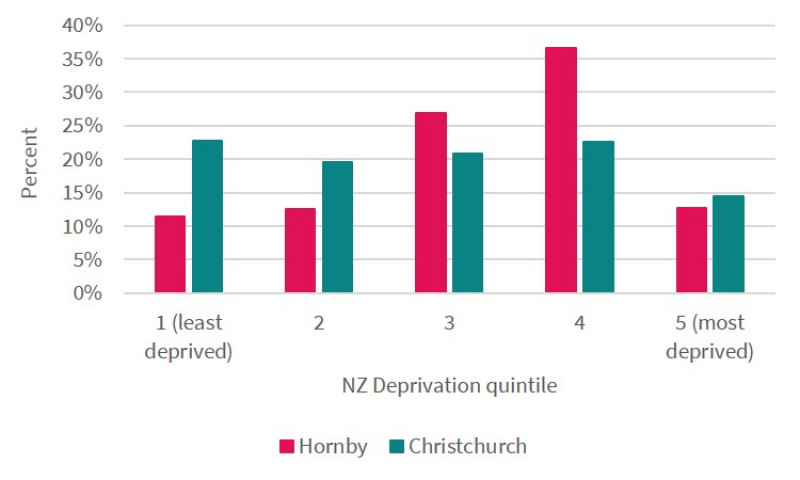
Population by deprivation quintile, 2018
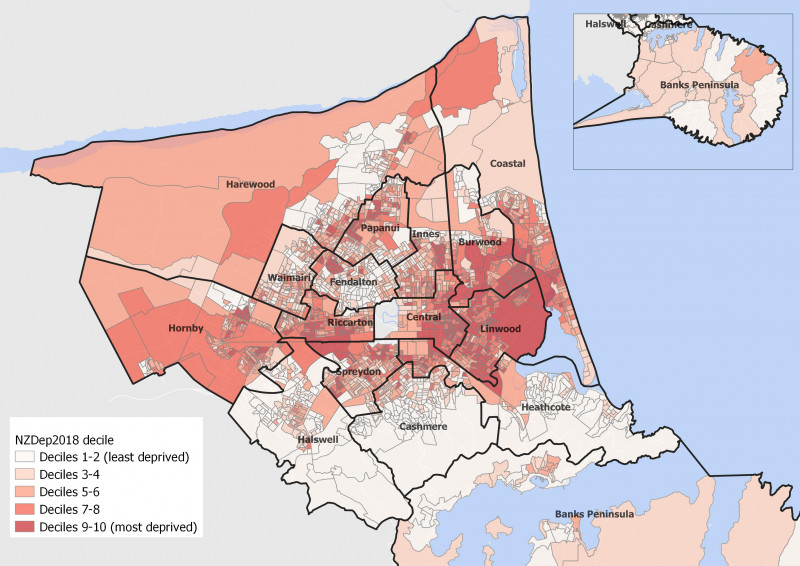
Deprivation Index, 2018
- View interactive map down to street block level(external link) (Massey University)
The 2018 deprivation index(external link) was developed by researchers at the University of Otago, and combines nine variables from the 2018 census which reflect dimensions of socio-economic deprivation. NZDep2018 provides a deprivation score for each meshblock in New Zealand (a meshblock is generally the size of a street block in urban areas, containing approximately 30-60 dwellings). Deprivation scores apply to areas rather than individual people.
Disability
- In 2018, 8 per cent of this ward's population aged 5 years and over were classed as disabled. This was compared with 7 per cent for all of Christchurch.
A person is regarded as disabled if they have 'a lot of difficulty' or 'cannot do at all' one or more of the six activities in the Activity limitations questions. These six questions are the Washington Group Short Set of questions on Disability and are referred to as Activity limitations in the 2018 Census. The questions relate to difficulty: seeing; hearing; walking or climbing steps; remembering or concentrating; washing all over or dressing; and communicating.
Number of motor vehicles
-
- In 2018, 6 per cent of households in Hornby ward did not have a motor vehicle, compared to 7 per cent of all Christchurch households.
- 73 per cent of households had either one or two motor vehicles, compared with 74 per cent city-wide.
Travel to work
-
- In 2018, 82 per cent of workers in Hornby ward (aged 15 years or over) usually travelled to work in a private or company car/truck/van, either as a driver or passenger. City-wide, this was 76 per cent.
- 4 per cent usually travelled by bus, 3 per cent by bicycle, 3 per cent by walking/jogging, while 7 per cent usually worked at home.
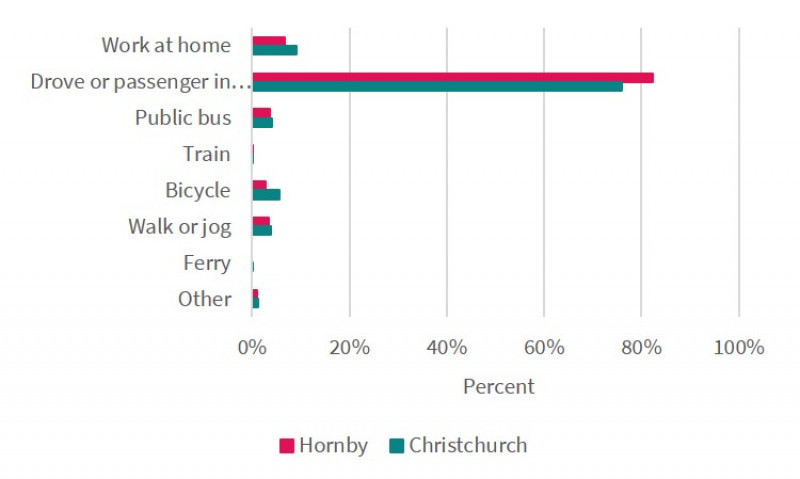
Travel to work (usual means), 2018
Travel to education
-
- In 2018, 52 per cent of students in Hornby ward (aged 15 years or over) usually travelled to their place of education in a private or company car/truck/van, either as a driver or passenger. City-wide, this was 44 per cent.
- 23 per cent usually travelled by bus, 3 per cent by bicycle, 9 per cent by walking/jogging, while 12 per cent usually studied at home.
Dwellings
- In 2018, there were 8,750 dwellings in Hornby ward. Of these, 8,150 were occupied private dwellings (93 per cent), and around 5 per cent were unoccupied private dwellings (i.e. dwelling was either empty or the occupants were away).
- Almost 2 per cent of all dwellings were under construction, and less than 1 per cent were occupied non-private dwellings (e.g. hostels, boarding houses, motels etc).
- Of the occupied private dwellings, 89 per cent were separate houses and 11 per cent were two or more flats/units/townhouses/apartments joined together.
Home ownership and rentals
- 67 per cent of households in Hornby ward owned the dwelling that they lived in (includes family trusts). This was 64 per cent for all of Christchurch.
- For the households renting their dwelling (33 per cent), the majority paid rent to a private landlord (81 per cent).
- 16 per cent of rented dwellings were owned by Housing New Zealand/Kāinga Ora, compared with 12 per cent for all of Christchurch City.
- 2 per cent of rented dwellings were Council-owned housing, compared with 3 per cent of city-wide dwellings.
- Median rent was $380, compared with $350 for Christchurch City as a whole.
Further information about census data
Information about census variables used in these profiles, including definitions and data quality ratings, can be found here(external link).
Community profiles
The 2025 profiles are compiled by the Community Support and Partnerships Unit. They are a record of the community at the point in time they were compiled – April 2025 – so some information may now be outdated.
Profiles include core demographics, community infrastructure and community resilience.
- Hornby Community Profile 2025 [PDF, 1.2 MB]
Email us for further demographic information for wards or community boards.
Related news

New alcohol rules for Christchurch
Christchurch City Council has adopted a new series of rules that set out how alcohol should be sold and supplied.
30 Jun 2025
Christchurch’s plans finalised for next year
Christchurch City Council has confirmed its plans for the year ahead, with the adoption of the Annual Plan 2025/26.
26 Jun 2025
News in brief from the Christchurch City Council meeting
Improvements on Moorhouse Avenue, speed limits around schools, tsunami sirens and Central City development contributions – here are the key decisions made at today's Christchurch City Council meeting.
18 Jun 2025